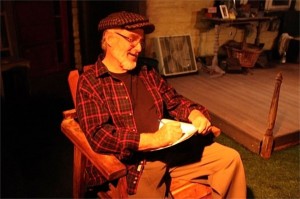Proof compels with mathematic precision
A compelling work of theater is one that draws in the audience through a visceral connection to the characters and the situations that they find themselves in. The audience needs to truly care about the fates of the people before them, either in a positive or negative light, for the story to become important and impactful.

A brilliant mind · James Whitmore Jr. plays a math professor who leaves behind mathematical equations for his daughter to find in Proof. – Courtesy of Aliah Whitmore
The premiere of Hayworth Theatre’s production of David Auburn’s Proof successfully creates this sense of connection and meaning. Under Aliah Whitmore’s directing, the play takes a more symbolic and mysterious approach to the story and adds new elements to both the theatrical and technological aspects of the performance.
Proof is a play that revolves around realism and focuses on the life of Catherine (Daniela Ruah), a young mathematics student who is forced to drop out of college to take care of her father (James Whitmore Jr.), a genius former math professor at the University of Chicago who has slowly begun his descent into madness. The intrigue grows when the professor passes away yet still continues to have conversations with his daughter.
Meanwhile, one of the professor’s students, Hal (Dustin Seavey), comes to Catherine’s home after her father’s death in order to search for any possible mathematical proofs that the professor may have worked on in the last few years of his life. Though Catherine initially resents this intrusion, she comes to deeply trust and care for Hal — only to discover he might only be after the fame and fortune that her late father’s work could bring him.
To add to this upheaval and confusion in Catherine’s life, her concerned sister, Claire (Whitmore), comes down from New York.
Even though, as mentioned, this play is often crafted as a more realistic show, Whitmore stages this particular production with several heavily symbolic elements that add a new and interesting perspective to the story.
For starters, Whitmore includes the use of speakers that emit angry, sinister or haunting whispers in moments when Catherine is experiencing mental anguish or emotional upheaval. This allows the audience to experience Catherine’s perspective when she begins to doubt her sanity.
The problem is that sometimes the sounds are abruptly introduced or cut off and can feel a little bit out of place with the pacing of a scene.
Another new addition to the play is the symbolic use of masks during transitions between scenes. Masked actors walk into the house on set and peer through an eerily-lit window while the rest of the stage is left dark.
But again, though the symbolism adds a new layer through which to interpret the production, it also unfortunately creates some confusion as to the meaning of the masks in relation to the characters and the action happening on stage.
There is also the issue of having a tree in the corner of the stage with mask-like faces carved into it. The tree is never addressed nor highlighted in the performance. The actors ignore it and no blocking is chosen to work around it. Yet, it seems to be an integral part of the story — it is just unclear what its function might be.
As much as these symbolic elements add a new level of depth and interest to the plot, a secondary downside to this approach is the subsequent emphasis on Catherine’s potential mental instability.
The masks, the tree and the sinister whispers all direct the focus of the play to the issue of Catherine’s sanity, rather than allowing the show to explore the true power and potential of women. The play is in and of itself a social critique on the sexist attitude toward women in academia, and the symbolic approach takes too much focus and reflection off of that element of the script.
Indisputably, however, the performances delivered by the outstanding cast are truly the highlights of the evening. Ruah delivers an especially standout performance, taking the character in a more vocal and visceral direction than often seen while also infusing Catherine with a childlike sense of vulnerability and fiery spirit.
Also notable is Whitmore Jr.’s performance as Robert — even though his character is dead for the majority of the play, his presence and commitment to the role captures your attention every time he came on stage.
Despite some of the holes in the Proof, its powerful story and its characters ultimately round out the production, leaving viewers with an impressive theatrical experience.
Proof is playing at the Hayworth Theatre, located at 2511 Wilshire Blvd., Los Angeles, CA. 90057 until May 12. Tickets are $25 for regular admission and $10 for students and senior citizens. For reservations or more information contact 818-826-3609 or visit www.whitmoreeclectic.com
